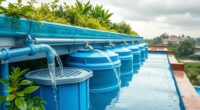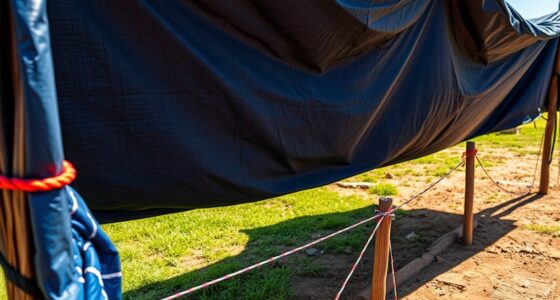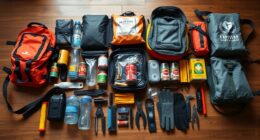When you're in the wilderness, finding clean water is essential. Look for rivers, streams, and lush vegetation where indicators like willows suggest nearby water. Follow animal tracks and observe birds flying low; they often lead to water sources. Collect dew from grass using absorbent cloths and rainwater with tarps. Always purify water by boiling, using purification tablets, or UV devices to ensure it's safe to drink. Stick around to discover more survival tips on managing water.
Key Takeaways
- Look for clear, fast-moving rivers and streams as they usually provide cleaner water than stagnant sources like lakes and ponds.
- Identify lush vegetation, such as willows and cattails, as indicators of nearby water sources.
- Collect dew using absorbent cloths placed overnight in dense grass for a natural hydration source.
- Always purify water by boiling, using chemical treatments, or filtration before drinking to ensure safety.
- Utilize portable water containers and purification tools, such as UV light devices or filtration systems, for efficient water collection and treatment.
Identifying Natural Water Sources
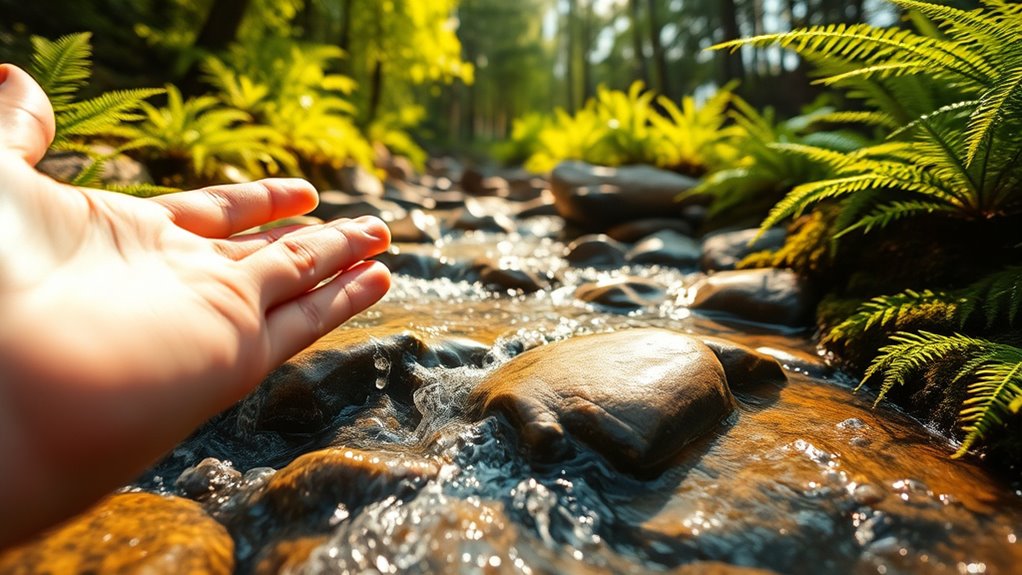
Finding clean water in the wilderness is crucial for survival, and identifying natural water sources is your first step.
Focus on rivers and streams, as they provide a steady supply of clear, fast-moving water that's generally safer than stagnant options. Listen for the sound of running water; it'll guide you to these sources.
Lakes and ponds can also offer significant amounts of water, but remember they require purification due to potential contamination. Look for lush vegetation, which often indicates their presence.
Additionally, springs and seeps can be reliable sources, usually offering cleaner water.
Always purify any water before drinking, regardless of the source, to ensure your safety.
Using Natural Indicators for Water

When you're in the wilderness, using natural indicators can greatly enhance your chances of locating clean water.
Look for vegetation like willows, cottonwoods, and cattails, which thrive near water sources. Dense, lush foliage often signals moisture, especially in dry areas.
Follow animal tracks; converging paths and game trails in a "V" shape typically lead to water. Birds flying low suggest nearby sources as well.
Observe the landscape—valleys and fluvial depressions often hold water. Check for damp ground, which may indicate underground water.
Lastly, pay attention to atmospheric clues like fog, humidity, and even the color of the sky, as these can hint at water's presence nearby.
Stay alert to these signs, and your search will be more fruitful.
Collecting Dew and Rainwater

Collecting dew and rainwater can be a game-changer for staying hydrated in the wilderness. For dew, use absorbent cloths to gather moisture from grass or leaves early in the morning, when it's most plentiful.
Place multiple cloths overnight in areas with dense grass to maximize your collection. When it rains, be ready to capture that fresh water using tarps and containers. Look for natural depressions where water collects, and if you lack containers, use leaves to soak up rainwater.
Always prioritize clean collection practices to avoid contamination. Remember to filter any water you collect from polluted areas, and stay aware of your surroundings to ensure safety while gathering this essential resource.
Methods for Purifying Water

Purifying water in the wilderness is crucial for ensuring your safety and hydration. One of the simplest methods is boiling; just bring your water to a rolling boil for at least one minute to kill harmful pathogens.
If you have chemical treatments like iodine or chlorine, use them according to the instructions, keeping in mind that water clarity affects effectiveness.
Filtration is another option, as it removes parasites but not viruses. For a quick solution, UV light devices can purify water without changing its taste, though they need batteries.
Lastly, distillation involves boiling water and collecting the steam, perfect for high-mineral areas.
Always consider backup methods and stay aware of your water source's quality for effective purification.
Preparing for Survival Situations
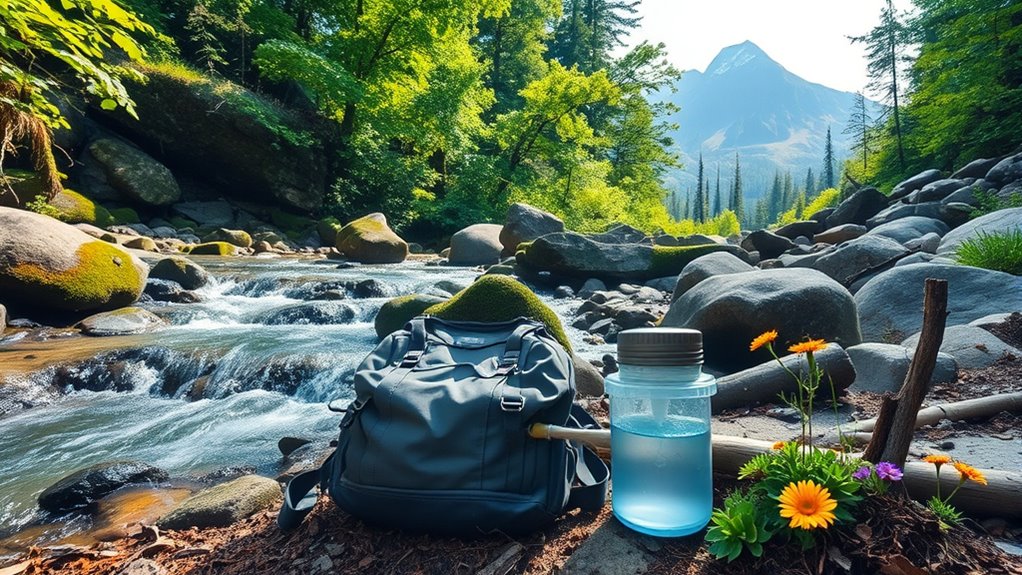
Survival situations can arise unexpectedly, so having a solid plan in place is vital. Start by preparing essential survival gear. Include fire starters like waterproof matches, lightweight shelter materials such as tarps, and durable water containers for hydration.
Navigation tools like a compass and topographic maps are crucial for finding your way. Don't forget a first aid kit stocked with bandages and antiseptic wipes.
Establish a hierarchy of needs focused on shelter, water, and food. Stay calm and assess your surroundings to make informed choices.
Develop survival skills, like fire-making and shelter building, and plan for emergencies by informing others of your itinerary. Cultivate a resourceful mindset, adaptability, and mental resilience to tackle challenges effectively.
Managing Water in Survival Situations

When you find yourself in a wilderness survival situation, managing your water supply becomes crucial for your well-being.
First, locate water sources by observing vegetation like willows or animal tracks converging in one direction. Listen for the sound of running water, too.
Collect rainwater with tarps and dew from plants to supplement your supply.
Always purify your water—boiling is the most reliable method, but you can also use sunlight or chemical tablets if boiling isn't possible.
Be aware of your hydration needs; aim for at least two quarts a day.
Conserve your water until you find more, and assess any new sources for contaminants.
Adapting to Weather Conditions

Once you've managed your immediate water needs, adapting to the weather conditions around you becomes vital.
In rainy weather, collect rainwater directly by setting up gutter systems or using rain barrels to store this clean resource. If you're in a pinch, create a tarp system to channel rain into containers or dig emergency pits to catch runoff.
In hot climates, utilize plant transpiration and condensation techniques to extract moisture from the air. Collecting dew in the mornings can also provide hydration.
In cold environments, melt snow or ice for water, but never consume it frozen. Always keep your collected water insulated to prevent freezing, ensuring you stay hydrated in any weather.
Essential Tools for Water Collection and Purification

Finding clean water in the wilderness requires the right tools to efficiently collect and purify it. Start with water containers like plastic bottles or collapsible bags to store your supply.
For filtration, consider portable devices like LifeStraw or Sawyer Mini, which remove harmful bacteria. Don't forget purification tablets or a UV light device to disinfect water further.
When collecting, utilize rainwater systems or dew collection cloths. For snow, have a portable stove ready to melt it down.
Always carry boiling equipment, like camp stoves, to ensure safety. Lastly, keep pre-filtration materials handy, such as cloths, to remove debris before purification.
With these essentials, you'll be better equipped to find and purify water in the wild.
Frequently Asked Questions
What Should I Do if I Can't Find Any Water Sources?
If you can't find any water sources, start by assessing your surroundings.
Look for signs of moisture, like lush vegetation or animal tracks, which often lead to water. You can also collect dew in the morning using cloth or plastic bags.
Try melting snow or ice if available.
Conserve your energy and stay positive, as keeping your morale up is crucial for survival.
Don't forget to monitor the environment for changing conditions.
How Can I Tell if Water Is Safe to Drink Without Testing?
Determining if water's safe to drink is like playing a game of detective.
Look for flowing water, as it's usually cleaner than stagnant sources. If it's clear and doesn't have an odd smell, you're in better shape.
Avoid water near dead animals or heavy vegetation. Always purify it if you're unsure. Boiling or filtering it can help eliminate harmful contaminants, giving you peace of mind during your adventure.
Stay alert and trust your instincts!
Is There a Way to Store Water Long-Term in the Wilderness?
Yes, you can store water long-term in the wilderness using various containers.
Food-grade plastic bottles are great for portability, while stainless steel containers are durable but can affect taste. If you need bulk storage, consider 55-gallon drums.
Always keep your containers sealed and store them in cool, dark places to prevent contamination. Rotating your water supply regularly helps maintain quality, ensuring you have safe water when you need it.
What Are Common Signs of Dehydration to Watch For?
You mightn't notice the signs of dehydration until you feel drained, and that's when it hits you.
Thirst, dry mouth, and dark urine signal mild dehydration. As it worsens, muscle cramps and dizziness can creep in, reminding you of the importance of fluids.
If you're feeling confused or faint, it's severe. Stay alert to these symptoms; they're your body's way of urging you to hydrate before it's too late.
How Can I Improve My Chances of Finding Water in Winter?
To improve your chances of finding water in winter, look for streams or rivers that might be frozen but have flowing water beneath.
Track animals, as they usually head to water sources at dawn or dusk.
Check valleys and low areas where water collects, and consider breaking ice on lakes.
You can also collect snow and melt it for drinking.
Always remember to purify any water before consuming it to ensure safety.
Conclusion
In the wilderness, you can find clean water, but it takes skill and awareness. While rushing to quench your thirst might seem tempting, patience and knowledge are your best allies. You're not just surviving; you're thriving by understanding your environment. Remember, a clear stream may sparkle invitingly, but always purify before drinking. With the right tools and techniques, you can transform uncertainty into security, ensuring you stay hydrated and alive in even the most challenging situations.


